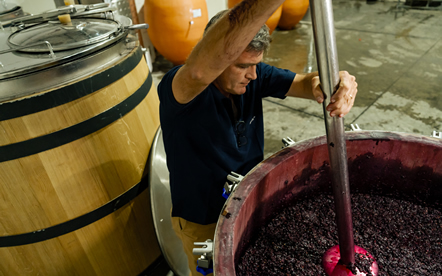
Vintage 2023: In which order are vines harvested?
At Luigi Bosca’s estates, the most important time of the year is coming: the vintage, representing the conclusion of the work performed for 12 months and the end of the vine’s annual cycle. To understand the relevance of the harvest, it is worth taking into account a phrase that embodies Engineer Alberto Arizu’s philosophy: “The wine is born in the vineyard, and that is the key element to obtain great wines.” This means that the grape’s health is crucial to ensure the good quality of the final product, to such an extent that, even when healthy grapes are harvested at the peak of ripeness, poor quality wines can be achieved if no proper care is taken for details at other stages of the winemaking process. Bad quality grapes will never result in great wines.
The winemaking industry considers healthy grapes as those fruits harvested at the right time, being neither green nor overripe, but at a balanced phenolic degree of ripeness. The grapes’ level of ripeness represents the must’s amount of sugar, which will be proportionate to the amount of alcohol to be present in the beverage after fermentation. For this reason, agricultural and winemaker teams work hand in hand to establish the peak of ripeness for grapes to be harvested at each of their estates.

Overall, the vintage begins with the picking of grapes to make the base wine for sparklings, as these are the ones that require the highest acidity levels.

But, in addition, each vine ripes in its own time: some varieties ripe earlier, whereas others take more time; in other words, they need longer to ripe for their proper winemaking process to take place. Why? On the one hand, because grapes harvested earlier may give rise to very acid, pungent wines, of lower alcohol content. On the other hand, very ripe grapes may result in heavier, greasier and highly alcoholic wines, excessively sweet, with notes of jam.
Overall, the vintage begins with the picking of grapes to make the base wine for sparklings, as these are the ones that require the highest acidity levels. These fruits (usually from the Chardonnay and Pinot Noir varieties) are harvested at a lower degree of ripeness to preserve their freshness, tension, and the typical acid note of said wines. These plots are followed by white grapes, which must also preserve their acidity and freshness, beginning with Sauvignon Blanc, an early variety. In order to preserve its varietal typicity, as in the Luigi Bosca Sauvignon Blanc, its sharp and vertical wines rely on the acid fresh fruit. Next comes Riesling, an inflexible variety, for which the proper work at the vineyard is even more important than the winemaking process conducted at the wine cellar to make lively, flowing and tense wines, such as the Argentine pioneer Luigi Bosca Riesling. Finally, Chardonnay grapes are picked to make simpler wines (riper than other white grapes), as this variety is usually chosen to make wider, more unctuous and well-bodied wines, in many cases partially aged in oak barrels, such as the De Sangre Chardonnay.
As for the red varieties, the first to be harvested is Pinot Noir, for the purposes of preserving its freshness, acidity and medium body, characteristics that can be clearly perceived in the Luigi Bosca Pinot Noir, followed by Malbec, Argentina’s emblematic vine, which provides more rounded wines that are sweeter at their core, like Luigi Bosca Malbec. Finally comes the Cabernet Sauvignon, the most sober and majestic red wine, whose most emblematic wines are usually aged in wood for a long time, such as Luigi Bosca Cabernet Sauvignon, aged in oak barrels for 14 months.
The peak of ripeness is crucial to achieve wines of balanced sugar and acidity levels, so paying high attention to detail at the moment of harvesting each variety is the first step towards producing unforgettable wines that will remain forever in the memory of those who drink them.




